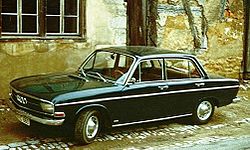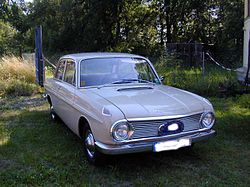- Audi F103
-
Audi F103 
Manufacturer Auto-Union Production September 1965 - July 1972
416,853 built[1] of which:
Sedan/Saloon: 386,361
Variant (station wagon/estate): 27,492Assembly Ingolstadt, Germany Predecessor DKW F102 Successor Audi 80 Class Compact executive car Body style 2 or 4-door saloon
3-door estateLayout Longitudinal front engine, front-wheel drive Engine 1.5–1.8 L inline-4 Transmission 4-speed manual Wheelbase 2,490 mm (98 in) Length 4,380 mm (172 in) Width 1,626 mm (64.0 in) Curb weight 960 kg (2,100 lb)−1,065 kg (2,350 lb) F103 is the internal designation for a series of car models produced by Auto Union in West Germany from 1965 to 1972, derived from the earlier DKW F102. To signify the change from a two-stroke to four-stroke engine, the DKW marque was dropped in favour of Audi, a name dormant since before the Second World War.
Contents
Models
The first model was launched simply as the Audi, later being renamed the Audi 72 (72 being the nominal power output of the engine in Pferdestärke).
The more powerful Audi 80 and Audi Super 90 sports saloons appeared in 1966: in 1968 the arrival of the less powerful Audi 60 completed the range.
The Audi 75 replaced both the Audi 72 and the Audi 80 from 1969 onwards.
In 1972 the F103 series was discontinued in favour of the "B1" Audi 80.
Engines
The F103 series were equipped exclusively with four-cylinder four stroke engines. These were longitudinally mounted. This combination of front-wheel drive, which Auto Union's DKW brand had pioneered during the 1930s, and the longitudinally positioning of a four cylinder engine would provide the basic template for Volkswagen's successful new Passat as well as the Audi models Audi 80 and Audi 100 after Volkswagen acquired the business from Daimler-Benz late in 1964. Since the chassis on the F103 was taken from the DKW F102 with a 3-cylinder two stroke engine the longer engine meant that the cooling system had to be offset to the left of the engine instead of the normal position in front of it.
The engines of the F103 series were a joint development with Daimler-Benz who owned Auto-Union at the time (from 1958 to 1964). They were dubbed the Mitteldruckmotor (medium pressure engines), because of their unusually high compression ratio, mid-way between conventional petrol and diesel engines.
Running gear
The car came with a four speed manual transmission.
Inboard mounted front disc brakes were featured,[2] which was still unusual in the mid-size car market at this time. The rear brakes followed the more conventional drum configuration.
Bodywork
The F103 bodyshell was a development of the earlier DKW F102. The engine compartment had to be extended so that the new four-cylinder engine could be accommodated. The front and tail were also cosmetically revised: Audi F103s sold in Europe all featured quasi-rectangular headlamps which were becoming fashionable at the time, whereas the F102 had used round headlamp units.
All Audi F103 models were offered as saloon|sedans with two and four doors. However, the two door saloon/sedan was not sold in markets with little demand for two door cars of this size, such as Italy and Britain.
With the exception of the Audi Super 90, the F103 series were available also as three-door estate|station wagon models. Making its debut at the Geneva Motor Show in March 1966,[3] this was called, like the Volkswagen estate/station wagon models, Variant.
Commercial
During the early 1960s Auto Union was in commercial retreat: the Audi F103 was a relative success when compared with recent Auto Union products even if its commercial success was trumped by subsequent Audi models. In July 1967 it was reported that 100,000 Audis had been completed:[2] production of the F103 had by now built up to a rate of almost 40,000 per year and the company was moved to deny speculation that another new Audi model would be presented at the Frankfurt Motor Show in the Autumn / Fall of 1967.[2] (The Audi 100 was introduced only towards the end of 1968.)
Specifications
Manufacturer's figures except where stated[1]
Audi F103 Audi 60
2 or 4-door saloon/sedan
3-door ‘Variant’ estate/station wagonAudi 72
2 or 4-door saloon/sedan
3-door ‘Variant’ estate/station wagonAudi 75
2 or 4-door saloon/sedan
3-door ‘Variant’ estate/station wagonAudi 80
2 or 4-door saloon/sedan
3-door ‘Variant’ estate/station wagonAudi Super 90
2 or 4-door saloon/sedanProduced (years): 1968–1972 1965–1969 1969–1972 1966–1969 1966–1972 Produced (units – excludes estate 'Variant' bodied cars): 216,988 122,579 49,794 Engine: 4-cylinder-inline engine (four-stroke), longitudinally front-mounted Bore x Stroke: 80 x 74.4 80 x 84.4 81.5 x 84.4 Displacement: 1496 cc 1695 cc 1761 cc Max. Power: 55 PS / 54 hp / 40 kW
65 PS / 64 hp / 48 kW72 PS / 71 hp / 53 kW 75 PS / 74 hp / 55 kW 80 PS / 79 hp / 59 kW 90 PS / 89 hp / 66 kW Compression Ratio: 9.1 : 1 11.2 : 1 [4] 9.1 : 1 - 10.6 : 1 Acceleration 0 – 100 km/h /
0 – 62 mph (seconds):18.0 14.8 14.5 14.0 12.2 Max Speed km/h (mph) : 138 km/h (86 mph)
144 km/h (89 mph)148 km/h (92 mph) 150 km/h (93 mph) 152 km/h (94 mph) 163 km/h (101 mph) Fuel feed: single Solex carburetor Valvetrain: - Cooling: Water Electrical system: 12 volt Front suspension: Independent torsion bar Rear suspension:: Torsion bar Brakes: Front discs / Rear drum brakes Body structure: Monocoque Dry weight: 960 kg (2,100 lb) - 1,065 kg (2,350 lb) Track front/rear: 1,343 mm (52.9 in) / 1,327 mm (52.2 in) Wheelbase: 2,490 mm (98 in) Length: 4,380 mm (172 in) Width: 1,626 mm (64.0 in) Height: 1,451 mm (57.1 in) Steering: rack & pinion Turning circle: 10.59 m / 34'9" [4] References
- ^ a b Oswald, Werner (1. Auflage 2001). Deutsche Autos 1945-1990, Band 4. Stuttgart: Motorbuch Verlag. ISBN 3-613-02131-5.
- ^ a b c "Exhibition Stand 107 Auto Union". Autocar. 127 (nbr 3740): 28. October 1967.
- ^ "36th Geneva Salon". Autocar. 124 (nbr 3657): pages 540–546 & 581. date 18 March 1966.
- ^ a b Cardew, Basil (1966). Daily Express Review of the 1966 Motor Show. London: Beaverbrook Newspapers Ltd.
- This article incorporates information from the revision as of 2008-03-04 of the equivalent article on the German Wikipedia.
- This article incorporates information from the revision as of 2008-03-04 of the equivalent article on the Italian Wikipedia.
External links
- Good overview of the development of the DKW F103 to the Audi 60 (in German)
- A Super 90 at a vintage rally
Audi timeline, European market, 1970s–present — a marque of the Volkswagen Group type /
class1970s 1980s 1990s 2000s 2010s 0 1 2 3 4 5 6 7 8 9 0 1 2 3 4 5 6 7 8 9 0 1 2 3 4 5 6 7 8 9 0 1 2 3 4 5 6 7 8 9 0 1 supermini 50 (86) A2 (8Z) A1 (8X) small family car A3 (8L) A3 (8P) S3 (8L) S3 (8P) compact
executive carF103 series 80 (82) 80 / 90 (81) 80 / 90 (89) 80 (8C) A4 (8D) A4 (8E) A4 (8K) S2 S4 (8D) S4 (8E) S4 (8K) mid-size
executive car100 (F104/43/44/4A) / 200 (44) A6 (4A) A6 (4B) A6 (4F) Ur-S4 (4A) Ur-S6 (4A) S6 (4B) S6 (4F) large
luxury carV8 (4C) A8 (4D) A8 (4E) A8 (4H) S8 (4D) S8 (4E) small coupé TT Coupé (8N) TT Coupé (8J) small roadster TT Roadster (8N) TT Roadster (8J) mid-size
coupé100 Coupé S Coupé (81) Coupé (89) A5 (8T)/S5 (8T) mid-size
convertibleCabriolet (8G) A4 Cabriolet (8H) A5 Cab (8F) S4 Cab (8H) S5 Cab (8F) large coupé A7 (4G) executive
sports carQuattro (Ur-Quattro) RS2 Avant RS4 (8D) RS4 (8E/8H) RS6 (4B) RS6 (4F) sports car R8 (42) crossover
SUVA4 allroad quattro (8K) allroad quattro (4Z) A6 allroad quattro (4F) mid-size SUV Q5 (8R) large SUV Q7 (4L) homologation
road / rally carQuattro
A1 & A2Sport Quattro Sport Quattro S1 founder: August Horch • Audi corporate website • A marque of the Volkswagen Group • quattro GmbH • Audi S and RS models • Audi Centre of Excellence • Audi Channel • Audi Driving Experience Audi timeline, North American market, 1980–present — a marque of the Volkswagen Group type 1980s 1990s 2000s 2010s 0 1 2 3 4 5 6 7 8 9 0 1 2 3 4 5 6 7 8 9 0 1 2 3 4 5 6 7 8 9 0 1 compact
luxury carA3 (8P) 4000 (81) 80 / 90 (89) 90 (8C) A4 (8D/8E/8H/8K) 4000 CS quattro S4 (8D/8E/8H/8K) mid-size luxury car 5000 (43) 100 / 200 / 5000 (44) 100 / A6 (4A) A6 (4A/4B/4F) Ur-S4 Ur-S6 S6 (4B) S6 (4F) A7 (4G) full-size car V8 (4C) A8 (4D/4E/4H) / S8 (4D/4E) coupé Coupé (81) Coupe Quattro (89) A5 / S5 (8T) small coupé TT Coupé (8N) TT Coupé (8J) small roadster TT Roadster (8N) TT Roadster (8J) convertible Cabriolet (8G) A4 Cabriolet / S4 Cabriolet (8H) A5 Cab / S5 Cab (8F) sports
carQuattro (Ur-Quattro) RS6 (4B) RS4 (8E/8H) R8 (42) compact
crossover SUVQ5 (8R) mid size
crossover SUVallroad quattro (4Z) A6 allroad quattro (4F) full size
crossover SUVQ7 (4L) founder: August Horch • Audi corporate website • A marque of the Volkswagen Group • quattro GmbH • Audi S and RS models • Volkswagen Group of America, Inc. • Volkswagen Group of America corporate website • Electronics Research Laboratory • North American Volkswagen engines • Audi Driving Experience Categories:- Audi vehicles
- Executive cars
- Mid-size cars
- Sedans
- Station wagons
- Front wheel drive vehicles
- Vehicles introduced in 1965
- 1960s automobiles
- 1970s automobiles
Wikimedia Foundation. 2010.

